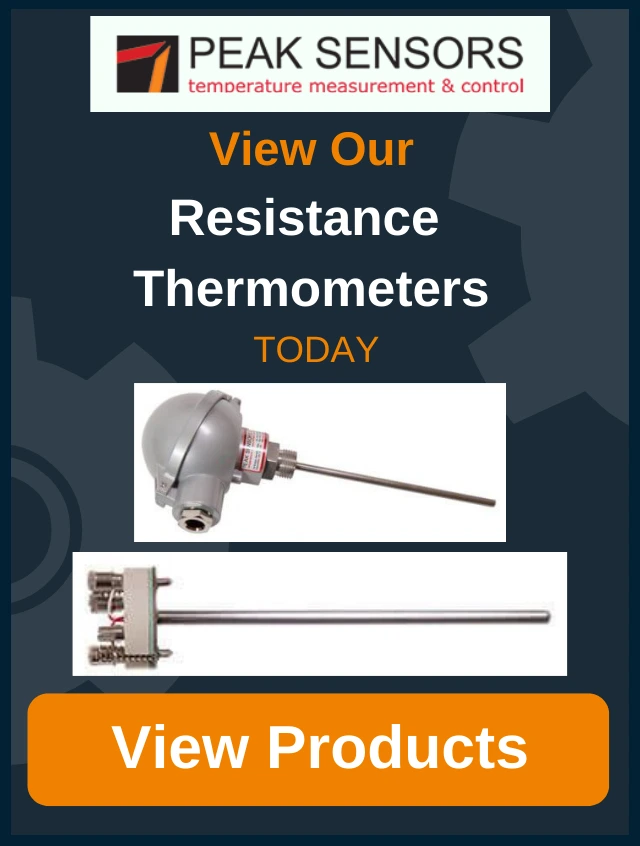Platinum Resistance Thermometer Information
Platinum Resistance Thermometers (Pt100, Pt1000, RTD)
Resistance thermometers are slowly replacing thermocouples in many lower-temperature industrial applications (below 600°C). Resistance thermometers come in a number of construction forms and offer greater stability, accuracy and repeatability. The resistance tends to be almost linear with temperature. A small power source is required.
No special extension cables or cold junction compensations are required The resistance of a conductor is related to its temperature. Platinum is usually used due to its stability with temperature. The Platinum detecting wire needs to be kept free of contamination to remain stable. A Platinum wire or film is created and supported on a former in such a way that it gets minimal differential expansion or other strains from its former, yet is reasonably resistant to vibration.
Commercial platinum grades are produced which exhibit a change of resistance of 0.385 Ohms/°C (European Fundamental Interval) The sensor is usually made to have 100 Ohms at 0 °C. This is defined in BS EN 60751:2008. The American Fundamental Interval is 0.392 Ohms/°C.
Resistance thermometers require a small current to be passed through in order to determine the resistance. This can cause self heating and manufacturers limits should always be followed along with heat path considerations in design. Care should also be taken to avoid any strains on the resistance thermometer in its application.
Lead wire resistance should be considered and adopting three and four wire connection strategies can result in eliminating connection lead resistance effects from measurements.
Resistance thermometers elements are available in a number of forms. The most common are:
- Wire Wound in a ceramic insulator – High temperatures to 850 °C
- Wires encapsulated in glass – Resists the highest vibration and offers most protection to the Pt
- Thin film with Pt film on a ceramic substrate – Inexpensive mass production
Resistance Thermometer Construction

RTD elements will nearly always require insulated leads attached. At low temperatures PVC, Silicon rubber or PTFE insulators are common to 250 °C. Above this Glass fibre or ceramic are used. The measuring point and usually most of the leads require a housing or protection sleeve. This is often a metal alloy which is inert to a particular process.
Often more consideration goes in to selecting and designing protection sheaths than sensors as this is the layer that must withstand chemical or physical attack along with offering convenient process attachment features.
Standard Platinum Resistance Thermometer Data
Temperature sensors are usually supplied with Thin film Elements.
These are rated as:
Continuous operation | -70 to +500 °C |
Tolerance class B / W 0.3 / F 0.3 | -70 to +500 °C |
Tolerance class A (1/2B) / W 0.15 / F 0.15 | -30 to +350 °C |
Tolerance class 1/3B / W 0.1 / F 0.1 | 0 to +100 °C |
Resistance Thermometer elements can be supplied which function up to 850 °C.
Sensor Tolerances are calculated as:
Class B / W 0.3 / F 0.3 | change in t=+/- (0.3+0.005|t|) |
Class A / W 0.15 / F 0.15 | change in t=+/- (0.15+0.002|t|) |
1/3 Class B / W 0.1 / F 0.1 | change in t=+/- 1/3 x (0.3+0.005|t|) |
1/5 Class B | change in t=+/- 1/5 x (0.3+0.005|t|) |
1/10 Class B | change in t=+/- 1/10 x (0.3+0.005|t|) |
Where |t| = temperature in °C ignoring any mathematical sign.
Example 1: Class A at 50°C would be
(0.15 + 0.002 * 50) = +/- 0.25°C.
Example 2: Class A at -20°C would be
(0.15 + 0.002 * 20) = +/- 0.19°C.
Where elements have a resistance of n x 100 Ohms then the basic values and tolerances also have to be multiplied by n
The above data is from BS EN 60751:2008
Resistance Thermometer Wiring Configurations
Resistance thermometers are available in a number of wire configurations. It is your choice what configuration is best for your situation. A number of factors will influence your decision such as instrumentation but the main trade off with each configuration is cost vs accuracy. Generally the more wires used the higher the accuracy but also the higher the cost of the sensor.
Two Wire Configuration
The simplest resistance thermometer configuration uses two wires. It is only used when high accuracy is not required as the resistance of the connecting wires is always included with that of the sensor leading to errors in the signal. Using this configuration you will be able to use 100 metres of cable. This applies equally to balanced bridge and fixed bridge systems. The values of the lead resistance can only be determined in a separate measurement without the resistance thermometer sensor and therefore a continuous correction during the temperature measurement is not possible.
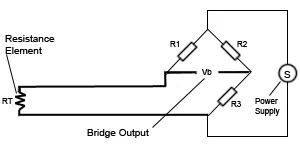
Three Wire Configuration
In order to minimise the effects of the lead resistances a three wire configuration can be used. Using this method the two leads to the sensor are on adjoining arms, there is a lead resistance in each arm of the bridge and therefore the lead resistance is cancelled out. High quality connection cables should be used for this type of configuration because an assumption is made that the two lead resistances are the same. This configuration allows for up to 600 metres of cable.
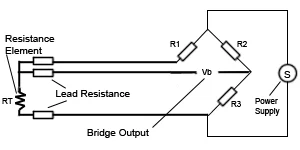
Four Wire Configuration
The four wire resistance thermometer configuration even further increases the accuracy and reliability of the resistance being measured. In top diagram a standard two terminal RTD is used with another pair of wires to form an additional loop that cancels out the lead resistance. The top wheatstone bridge method uses a little more copper wire and is not a perfect solution. The bottom diagram is an better alternative configuration that we use in all our RTD’s. It provides full cancellation of spurious effects and cable resistance of up to 15 ohms can be handled.
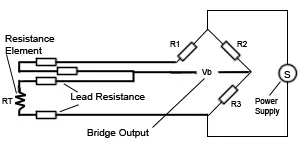
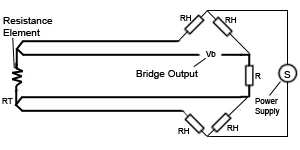
More Information
Our engineers are always available to help you choose the right type of product to meet your needs. So please contact us now with any enquiries you have.


If you want to order a temperature sensor or you are unsure exactly what you need, get in touch and we can help you.
Submit an Enquiry
"*" indicates required fields

